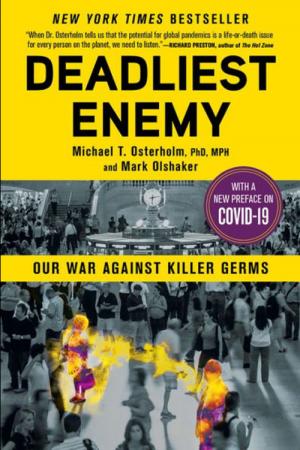By Nancy Brannon
On Wednesday June 17, 2020 on NPR’s Fresh Air, Terry Gross interviewed epidemiologist Michael Osterholm, Ph.D. about the COVID-19 pandemic. He is the founder and director of the Center for Infectious Disease Research and Policy at the University of Minnesota. His 2017 book, Deadliest Enemy: Our War Against Killer Germs,was recently republished with a new foreword about COVID-19.
Osterholm told Gross that face masks and physical distancing remain the best practices in terms of curbing the spread of the coronavirus. But he added that social distancing is the wrong term. “It’s physical distancing,” he explained. “Don’t socially distance. If there was ever a time when we all need each other, it’s now. We need to start an epidemic of kindness right now to take on this virus pandemic.”
From March 19 through June 18, there were hundreds of new cases every day, totaling 32,829 cases and 509 deaths in Tennessee, and 20,641 confirmed cases and 938 deaths in Mississippi. With state economies opening up in phases, the virus contagion rate increased.
Osterholm explained how the virus spreads and predicted that “It may come and go, but it will keep transmitting until we get at least 60% or 70% of the population infected and, hopefully, develop immunity — or if we get a vaccine…
“One of the challenges we have with this disease is making sure that we really have accurate and actionable information for the public.” He said that looking back over “research dating back for decades about these kinds of respiratory transmitted infections,” the data show the main way the virus is transmitted: “Breathing someone else’s air where the virus is present.” He said that surfaces play very little role in transmission. “It's the air that we share with each other that is critical. That’s why distancing is so important.”
He explained that being outdoors leaves one less susceptible to disease transmission. “The virus dissipates quite quickly into the air. If there’s any air movement around, it literally blows the cloud away and, in a sense, disintegrates it.
“The single greatest risk factor for transmitting this virus is largely indoor air, where we’re in large crowds, where we are sharing that air with the people right around us. Any activity that increases that, such as loud voices, shouting, singing, can enhance the virus being aerosolized or basically put into the air.
“Outdoors has its own natural air conditioning. Beaches are probably some of the safest places to go, if you’re not literally cheek and jowl with someone, just because the wind is blowing all the time.
“If you're in a building where the heating, ventilation, and cooling system is not moving air very frequently, then that aerosol that a person is breathing in a conference room is going to build up over time. You are going to be at greater risk in that kind of setting.”
Update on COVID-19:
As of Sunday June 28, 2020, global deaths reached 499,300, according to the Johns Hopkins University Coronavirus Resource Center, which includes more than 125,000 deaths in the U.S. The number of cases worldwide surpassed 10 million. The Centers for Disease Control and Prevention estimated that for every reported case, there were 10 other infections. That could mean more than 20 million infections in the U.S. alone. This week (June 21-27) the U.S. saw its highest daily increase of the pandemic, with more than 45,000 new cases reported Friday (June 26).
Dr. Anthony Fauci, director of the National Institute of Allergy and Infectious Diseases, warned that the infections will continue until people take responsibility for protecting themselves. “You have an individual responsibility to yourself, but you have a societal responsibility, because if we want to end this outbreak …we’ve got to realize that we are part of the process,” he said.
Sources:
“Amid Confusion About Reopening, An Expert Explains How To Assess COVID-19 Risk.” Fresh Air. NPR. June 17, 2020.
https://www.npr.org/2020/06/17/879255417/amid-confusion-about-reopening-an-expert-explains-how-to-assess-covid-risk
“Global Coronavirus Deaths Near 500,000 As Number Of Cases Surpasses 10 Million” NPR. June 28, 2020. https://www.npr.org/sections/coronavirus-live-updates/2020/06/27/884297509/global-coronavirus-death-toll-nears-500-000
On Wednesday June 17, 2020 on NPR’s Fresh Air, Terry Gross interviewed epidemiologist Michael Osterholm, Ph.D. about the COVID-19 pandemic. He is the founder and director of the Center for Infectious Disease Research and Policy at the University of Minnesota. His 2017 book, Deadliest Enemy: Our War Against Killer Germs,was recently republished with a new foreword about COVID-19.
Osterholm told Gross that face masks and physical distancing remain the best practices in terms of curbing the spread of the coronavirus. But he added that social distancing is the wrong term. “It’s physical distancing,” he explained. “Don’t socially distance. If there was ever a time when we all need each other, it’s now. We need to start an epidemic of kindness right now to take on this virus pandemic.”
From March 19 through June 18, there were hundreds of new cases every day, totaling 32,829 cases and 509 deaths in Tennessee, and 20,641 confirmed cases and 938 deaths in Mississippi. With state economies opening up in phases, the virus contagion rate increased.
Osterholm explained how the virus spreads and predicted that “It may come and go, but it will keep transmitting until we get at least 60% or 70% of the population infected and, hopefully, develop immunity — or if we get a vaccine…
“One of the challenges we have with this disease is making sure that we really have accurate and actionable information for the public.” He said that looking back over “research dating back for decades about these kinds of respiratory transmitted infections,” the data show the main way the virus is transmitted: “Breathing someone else’s air where the virus is present.” He said that surfaces play very little role in transmission. “It's the air that we share with each other that is critical. That’s why distancing is so important.”
He explained that being outdoors leaves one less susceptible to disease transmission. “The virus dissipates quite quickly into the air. If there’s any air movement around, it literally blows the cloud away and, in a sense, disintegrates it.
“The single greatest risk factor for transmitting this virus is largely indoor air, where we’re in large crowds, where we are sharing that air with the people right around us. Any activity that increases that, such as loud voices, shouting, singing, can enhance the virus being aerosolized or basically put into the air.
“Outdoors has its own natural air conditioning. Beaches are probably some of the safest places to go, if you’re not literally cheek and jowl with someone, just because the wind is blowing all the time.
“If you're in a building where the heating, ventilation, and cooling system is not moving air very frequently, then that aerosol that a person is breathing in a conference room is going to build up over time. You are going to be at greater risk in that kind of setting.”
Update on COVID-19:
As of Sunday June 28, 2020, global deaths reached 499,300, according to the Johns Hopkins University Coronavirus Resource Center, which includes more than 125,000 deaths in the U.S. The number of cases worldwide surpassed 10 million. The Centers for Disease Control and Prevention estimated that for every reported case, there were 10 other infections. That could mean more than 20 million infections in the U.S. alone. This week (June 21-27) the U.S. saw its highest daily increase of the pandemic, with more than 45,000 new cases reported Friday (June 26).
Dr. Anthony Fauci, director of the National Institute of Allergy and Infectious Diseases, warned that the infections will continue until people take responsibility for protecting themselves. “You have an individual responsibility to yourself, but you have a societal responsibility, because if we want to end this outbreak …we’ve got to realize that we are part of the process,” he said.
Sources:
“Amid Confusion About Reopening, An Expert Explains How To Assess COVID-19 Risk.” Fresh Air. NPR. June 17, 2020.
https://www.npr.org/2020/06/17/879255417/amid-confusion-about-reopening-an-expert-explains-how-to-assess-covid-risk
“Global Coronavirus Deaths Near 500,000 As Number Of Cases Surpasses 10 Million” NPR. June 28, 2020. https://www.npr.org/sections/coronavirus-live-updates/2020/06/27/884297509/global-coronavirus-death-toll-nears-500-000









